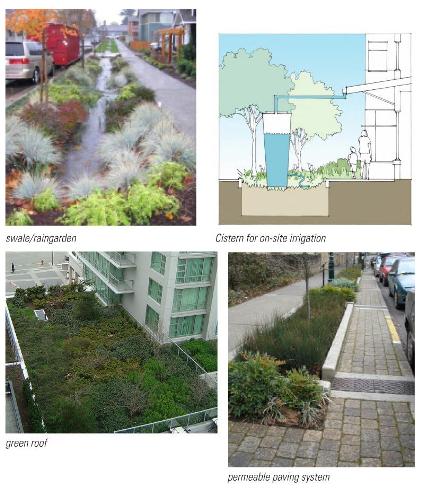Title 17E Environmental Standards
Chapter 17E.060 Shoreline Regulations
Article VIII. Design Standards Specific to Shoreline Districts
Section 17E.060.840 Design Standards Specific to the Great Gorge District
- Shoreline Relationships – Human Activity.
-
- Purpose.
To recognize that people’s relationship to the river and anticipated uses in the Great Gorge district will inform the design of the built environment. The Great Gorge district is a rugged area of steep bluffs, fast water, native plants and wildlife. Passive recreational opportunities are interwoven with residential uses. New development along the riverfront that maintains the natural character of the river gorge as a backdrop for recreation activities is encouraged. These include walking, bicycling, fishing, kayaking, rafting, observing birds/wildlife, and learning the stories of the river through interpretive displays.
-
- Along the river, new buildings shall provide at least two of the following (R):
-
-
- Outdoor seating areas.
-
-
- Benches along pedestrian trail.
-
-
- Outdoor balconies and decks.
-
-
- Public viewpoint with interpretive signs.
-
-
- Public art.
- Streets, Sidewalks and Trails – Pedestrian Pathways.
-
- Purpose.
To result in a pathway design, reflecting the mostly residential, lower intensity of adjacent development, as well as the modest level of pedestrian activity.
-
- Pedestrian pathways shall be at least ten feet wide. (R)
- Site Design.
-
- Landscape Character Protection.
-
-
- Purpose.
To protect, restore, and enhance the natural character of the river including its geologic features and native vegetation.
-
-
- Within the Great Gorge district, it is expected that there will be a very soft, open, informal, “naturalistic” approach to landscape design that reinforces the shoreline environment. Developments will be loosely arranged on the landscape, with a considerable amount of planting, including ground covers, understory, and trees. Landscape designs that include large lawn areas requiring fertilizers and herbicides, or vegetation that is highly consumptive of water should be avoided. (C)
-
-
- Native vegetation should predominate. (C)
-
-
- If buildings require exposed pilings for support on hillsides, the ground under the building shall be planted with shade tolerant plantings. Exposed soil shall not be allowed. (R)
-
-
- Exposed pilings should be colored to blend with native rock and the pilings and open space should be screened by tall vegetation. (C)
-
- Impervious Surfaces.
-
-
- Purpose.
To recognize that the Great Gorge area will have more open development that can allow for more pervious surfaces.
-
-
- Development shall incorporate ways of capturing and filtering run-off so that when it reaches the river, it has been moderately cleaned. This shall be accomplished through creative designs of courtyards, greens, planting areas, parking lots, and roof scuppers and other features. Generally, new development shall attempt to achieve at least twenty percent pervious surfaces on the site. The installation of “green roofs” can substitute for ground level treatment. (R)
-
- Pervious Surfaces.
-
-
- Purpose.
To create a system of spaces integrated with the ecological systems of the shoreline.
-
-
- Development shall include one or more of the following (R):
-
-
-
- Open spaces.
-
-
-
- Landscaped courtyards.
-
-
-
- Greenways.
-
-
-
- Pathways; or
-
-
-
- Other spaces that allow for a seamless connection between streets and various uses.
-
-
- Surfacing of these spaces shall allow for the capture of rainwater and filtration into a natural cleansing system of vegetation and sub-grade materials. (R)
-
- Planting Palette
-
-
- Purpose.
To recognize the dramatic natural landscape of the Great Gorge setting.
-
-
- Native plant material is strongly encouraged. Non-native, ornamental trees requiring large amounts of water and maintenance are strongly discouraged. Landscape designs should reflect a “natural” array of plantings, rather than a manicured or formal arrangement. However, there may be a few locations where specimen trees and formal configurations of plantings are appropriate, such as framing a public space or a building entrance. (C)
-
- Rain Gardens.
-
-
- Purpose.
To incorporate innovative methods of capturing and filtering run-off.
-
-
- Rain gardens should be integrated into planting strips along streets, as well as in exterior landscaped spaces. (C)
-
-
- Rain gardens shall not be adjacent to or within parking lots if it is determined that they will harm the aquifer. (R)

- Building Design – Character Related to the Setting.
-
- Purpose.
To ensure that new buildings are complementary or visually subordinate to the natural splendor of the river and falls, including its geologic features and native vegetation.
-
- Building design should not attempt to compete with the natural beauty of the river and the shoreline. It is expected that buildings will incorporate materials and colors that will be restrained and blend with native rocks and vegetation. (C)
- Lighting – Dark Sky.
-
- Purpose.
To reduce glare and spillover from lighting associated with parking lots or buildings.
-
- All lighting shall be directed downwards, with cut-off designs that prevent light from being cast horizontally or upward. (R)
-
- Building walls shall not be washed with light, nor shall high intensity security lighting be used to flood an area with light. (R)
-
- Parking lots shall be lighted with fixtures less than 22 feet in height. Single, high masts with multiple fixtures shall not be allowed. (R)
Date Passed: Monday, April 19, 2021
Effective Date: Sunday, May 23, 2021
ORD C36034 Section 15